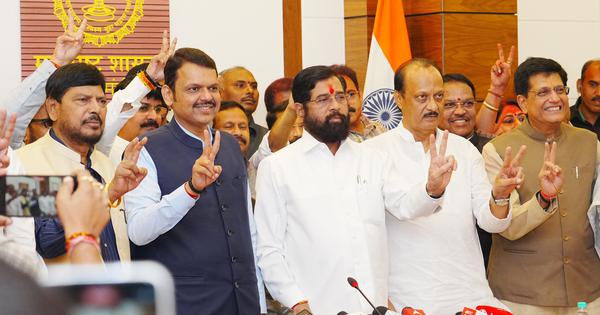
Veteran Congress leader Balasaheb Thorat has held the Sangamner assembly seat in Ahmednagar district since 1985. Even during the Modi wave of 2014, he retained the seat by a margin of nearly 59,000 votes. On Saturday, Throat lost to Shiv Sena’s Amol Khatal.
Another Congress old-hand, former chief minister Prithviraj Chavan, was bested by the Bharatiya Janata Party’s Atul Bhosale from Karad South in Satara district. Satara and Ahmednagar (now renamed Ahilyanagar) in Western Maharashtra have long been bastions of the Congress and its Nationalist Congress Party ally. Until recently, the region was considered impregnable to the BJP.
But by Saturday evening at 8.30, the BJP-led Mahyuti alliance was ahead in 41 of the 58 seats in the region.
In fact, the ruling coalition consisting of the BJP, the Shiv Sena faction led by Eknath Shinde and the Ajit Pawar faction of the Nationalist Congress Party dominated all regions in the state. It was heading for a majority of more than three-fourths, leading in 230 of the 288 seats in the assembly.
The Mahayuti won a staggering 48.16 % of the votes while the Maha Vikas Aghadi garnered 33.65%. The Opposition coalition comprises the Congress, the Shiv Sena faction headed by Uddhav Thackeray and the Nationalist Congress Party group headed by Sharad Pawar.
What explains this stunning turnaround less than six months after the Lok Sabha elections, in which the Mahayuti won only 17 of the state’s 48 seats?
Pre-election welfare bonanza
Widely credited with helping the Mahayuti coalition is the cash transfer scheme for women that it launched on the eve of the elections. Under the Mukhyamantri Majhi Ladki Bahin Yojna, women between the ages of 21 and 65 years, with an annual family income of up to Rs 2.5 lakh, have been receiving Rs 1,500 per month since July. The majority of the 2.34 crore women who benefit from the scheme received a total of Rs 7,500 in their accounts before the date of polling.
In this election, the number of women who voted was nearly 6% higher than in the 2019 polls. It is being attributed to the welfare measure. In an interview to Scroll last week, political observer Girish Kuber said that the real credit for the game-changing impact of the scheme goes to the Election Commission for delaying the Assembly elections. This allowed the state to transfer four to five months of installments of benefits to women’s bank accounts.
Acknowledging this the momentum of the scheme, Chief Minister Eknath Shinde in his first remarks after the results said he was grateful to the ladki bahin or beloved sisters in the state for their support.
Rajdeep Sardesai, political analyst and author of The Election That Changed India, noted that women are swing voters in India. “I don’t recall a single election in the last decade where the party that won the election did not win the majority of the women vote,” he said.
Rural distress not a factor?
Jaideep Hardikar, author and journalist with the People’s Archive Of Rural India, says he finds it difficult to comprehend the losses of veterans like Balasaheb Thorat from Sangamner in Western Maharashtra or Yashomati Tahkur also of the Congress in Vidarbha.
“The election results are quite stunning, particularly the wide gap in vote share,” he said. In Bhandara, Gondia and Gadchiroli, the Adivasi vote seems to have shifted to the Mahayuti en masse, he said.
“Overall, rural distress, the crisis facing soybean and cotton farmers are issues that have been overpowered momentarily, it appears, by the direct benefit transfer scheme, primarily Ladki Bahin,” Hardikar added
This is also perhaps the reason why there was little purchase for Opposition narratives that found an echo during the Lok Sabha polls, such as the Constitution being in danger of being amended if the BJP won an overwhelming majority, Sardesai said.
Since this was a more localised election, voters were looking at more immediate benefits they were getting from schemes such as Ladki Bahin rather than “whether you are a Dalit or an OBC or a Maratha”, Sardesai said.
“If you were a woman who was getting the benefits, why would you not take that?” he asked. “I think it became more transactional and in a transactional election the welfare schemes that were being rolled out by the Mahayuti worked.”
Caste calculations
Election analyst Yogendra Yadav believes the blame lies with Maha Vikas Aghadi for failing to convert the challenges faced by citizens into a winning election narrative. “There were real grievances, real problems, but the MVA failed to convert them into electoral issues,” he said. “The onus was on them.”
He suggested that the BJPs “biggest success was that it managed to convert this into a hyper local election”. This ensured that the Marathas did not consolidate behind the Maha Vikas Aghadi despite being disenchanted with the ruling coalition for failing to include the community in the list of Other Backward Classes. Instead, the election was “candidate to candidate”. At the same time, “the BJP quietly consolidated the OBCs and the most disadvantaged Dalits”, Yadav said.
Yadav said that while he was not surprised by the election results, he was taken aback by the scale of the Mahayuti’s victory. “A 15% gap in vote share is somewhat spooky and strange,” he said. “The data will need to be studied closely”

